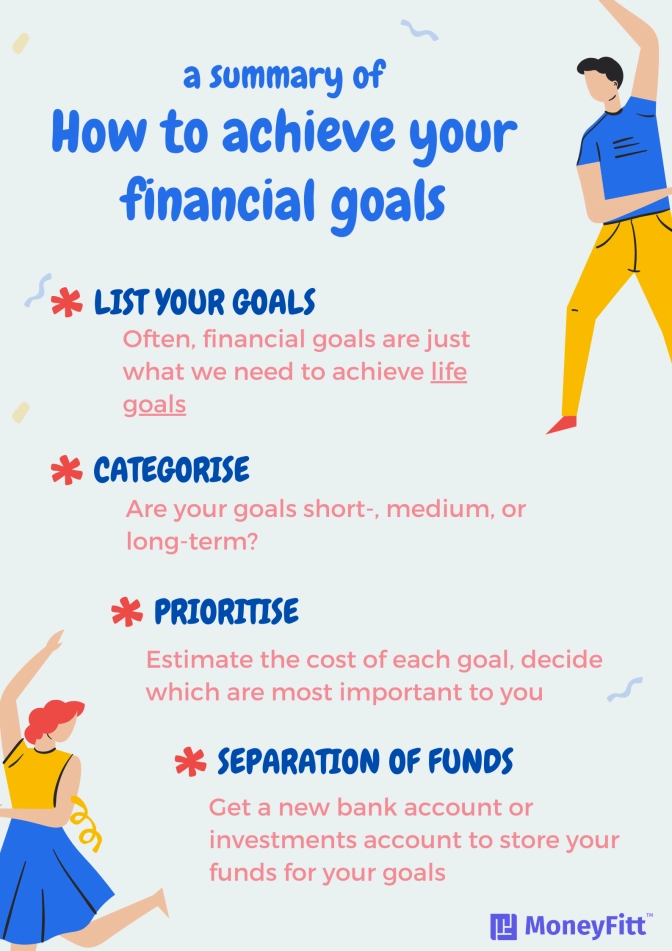How to Set and Achieve Your Financial Goals in 4 Steps
Helping you list, categorise and prioritise your financial goals
- Your goals will reflect what you care about most in life. Your financial goals are often life goals that have financial implications.
- Decide on your life goals and then estimate the cost of achieving those.
- Establish savings and investment accounts for your financial goals, separate from your day-to-day accounts.
What are your goals in life? Whether it’s to upgrade to a condo, get a top-tier sports car, or have enough to send your children to university overseas, we all have life goals we want to achieve.
More often than not, our life goals are tied to our finances, so planning how to achieve the necessary financial milestones is important. Planning how you'll achieve your financial goals allows you to better control the other things you care about in life.
There are multiple levels of goals, some far easier to achieve than others. Regardless of the difficulty or specificity, it’s important to craft good and achievable goals. This guide will show you good goals and how best to set them.
Setting Financial Goals

1. Calculating Your Net Worth
Your net worth is your personal balance sheet. It is your total assets minus total liabilities. Calculating your net worth can make it easier to assess the state of your current financial health.
It's crucial to understand the difference between an asset and a liability!
Assets are resources that you own and have the potential to supply you with future economic benefits. They can increase your net worth and help you achieve your financial goals. Examples include:
- Cash and cash equivalents (e.g. savings account balance, fixed deposits)
- Investments (e.g. shares, bonds, ETFs, life insurance value)
- Retirement plans (e.g. retirement savings account)
- Personal property (e.g. real estate, jewellery, vehicles, collectables)
Liabilities are debts or obligations which you need to pay off now or in the future. Can come in the form of money owed, goods needed to provide, or services required. They come to light out of past transactions and are settled with assets. Examples include:
- Credit card debt
- Payday loans
- Student loans
- Car loans
- Home mortgage
- Upcoming tax owings
- Current utility bills
Unfortunately, it's very common for individuals to find themselves with a negative net worth. Just aiming for an improved net worth is a great financial goal to start working towards if you find yourself in the red.

2. Create Your List of Financial Goals
After knowing your current net worth, it’s time to start creating a list of your financial goals. There are short-term, medium-term and long-term goals you can set, either by yourself or with a trusted financial advisor.
Here are some examples of goals you can set:
- Short-term goals: card repayments, home upgrade, increased income streams, or simply spending less, saving more | Timeline: 1 to 5 years.
- Medium-term goals: buying a car, wedding payment, putting a deposit on a new house | Timeline: 5 to 10 years.
- Long-term goals: retirement fund, child’s tertiary education fund, paying off a house loan | Timeline: 10 to 30 years.

As you can tell, long-term financial goals are mostly far out into the future and aim towards financial freedom. Because these are stretched over decades, short- and medium-term goals serve as targets in between. You can use these short-and medium-term targets as milestones to judge how well you do on your path to financial freedom.
3. Estimate the Cost of Each Goal
Once you've categorised your goals into short-, medium-, and long-term, estimating the cost of each goal is a sensible next step. It isn't too difficult to calculate the costs of short-term targets; however, medium- and long-term targets can be tricky to estimate. There are numerous tools available to help:
· FINRA’s College Savings Calculator
· FINRA’s Retirement Calculator
You should also assess how many goals you can work on at once. For example, if you have five short-term goals, you could decide to try accomplishing 1 or 2 short-term goals at once rather than all of them. You have to be realistic with your timing!
Having declared what your financial goals are and how they rank, assess your current expenses. Look to see if they're sensible or will hinder your progress. Be honest with yourself! This will help you make good decisions, like choosing the right-priced car, if any, for your family and not spending beyond your means.
4. Separation of Funds
To resist spending from your savings, consider opening up separate accounts for each major goal. For medium- to long-term targets, you can set up investment accounts. Investment accounts may not be suitable for short-term targets as you may need easy access to the money. Also, investments may be volatile and worth less at the time of withdrawal. This is also possible for medium and long-term goals, but historically that's been much less likely, and over time, investment accounts tend to outperform.
On that note, any investment should suit the time frame of your goal. Regarding the level of risk you choose with investments, you can stack your chances of triumph by avoiding big financial blow-ups. For non-professional investors, consider diversifying your investments to minimise the risk of financial loss without harming your potential return. Do keep in mind that for investing, it's essential to control rather than avoid risk. It is a long-term game, so don’t let short-term volatility or swings discourage you.

When weighing up your investment options, you should take the impact of inflation into account. Last year (2022), the global inflation rate was 8.73%* compared to 4.7% the previous year.
By reimagining how you spend, save, invest and even earn, you can ensure that your financial goals are achievable. Goal-setting is just the beginning of your journey to financial wellbeing, so start now!
FINANCIAL GOALS. COMPLETED. ✅
Sources:
